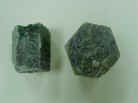EARTH SCIENCE
Platte Canyon High
School
Bailey, Colorado

USEFUL
INFORMATION
Mohs Hardness Scale
|
EARTH SCIENCE |
Platte Canyon High
School |
|
|
|
USEFUL
INFORMATION |
|
| ========================================================= | ||
|
Talc 1 |
|
Orthoclase 6 |
|
| Gypsum 2 |
|
Quartz 7 |
|
| Calcite 3 |
|
Topaz 8 |
|
| Fluorite 4 |
|
Corundum 9 | |
| Apatite 5 |
 |
Diamond 10 | |
|
THE RULES A B If A scratches B and B does not scratch A, then A is harder than B. If B scratches A and A does not scratch B, the B is harder than A. If B scratches A and A scratches B, the A and B are the same hardness.
|
BACKGROUND One of the properties of minerals that is used to distinguish one from another is HARDNESS. HARDNESS refers to how difficult it is to scratch a mineral. The harder the mineral is, the harder it is to scratch it. Minerals range from being very very soft (just about anything scratches them) to extremely hard (nothing else scratches them). An Austrian mineralogist Frederick Mohs in 1824 came up with a number scale of hardness which goes from 1 to 10. He arranged 10 minerals in order of hardness and assigned each one of these numbers. A hardness of 1 is very soft; 10 is very hard. |
TRICKS FOR
REMEMBERING To Go Carelessly Forward Against Ornery Quick Tigers Causes Death. Tall Gyroscopes Can Fly Apart, Orbiting Quickly To Complete Disintegration. Those Girls Can Flirt And Other Queer Things Can Do. |
|
|
ABSOLUTE HARDNESS SCALES The Mohs scale is a RELATIVE scale. That is, it only tells you that one mineral is harder or softer than another, but it does not tell you HOW MUCH harder or softer it is. Lets say that you are 16 and your younger brother or sister is 12. A RELATIVE scale would say that your brother is YOUNGER than you. An ABSOLUTE scale would say that he is 4 years younger than you or perhaps 75% of your age. There is an absolute scale for hardness, actually several. They all use an indentation method where an object (ball, cone) is pushed into the material by a certain amount of force and the size of the indentation gives a value related to its hardness. The most popular methods are Brinell, Vickers, Knoop and Rockwell. They are primarily used in the measuring of metal hardness. The first three are shown below in graphs where they are compared to the Mohs scale. |

| ================================================= |